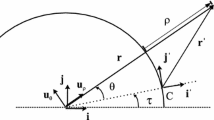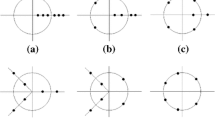Abstract
We derive the exact equations of motion for the circular restricted three-body problem in cylindrical curvilinear coordinates together with a number of useful analytical relations linking curvilinear coordinates and classical orbital elements. The equations of motion can be seen as a generalization of Hill’s problem after including all neglected nonlinear terms. As an application of the method, we obtain a new expression for the averaged third-body disturbing function including eccentricity and inclination terms. We employ the latter to study the dynamics of the guiding center for the problem of circular coorbital motion providing an extension of some results in the literature.




Similar content being viewed by others
Notes
In the CRTBP, \(m_{2}\) is fixed relatively to \(m_{1}\) in synodic axes.
This is confirmed by numerical simulations. In addition the corresponding value of a has been observed to be slightly greater than one for the large majority of test cases.
References
Battin, R.: An Introduction to the Mathematics and Methods of Astrodynamics. AIAA (1999)
Bombardelli, C., Gonzalo, J.L., Roa, J.: Approximate solutions of non-linear circular orbit relative motion in curvilinear coordinates. Celest. Mech. Dyn. Astron. 127(1), 49–66 (2017)
Brasser, R., Heggie, D., Mikkola, S.: One to one resonance at high inclination. Celest. Mech. Dyn. Astron. 88(2), 123–152 (2004)
Fleming, H.J., Hamilton, D.P.: On the origin of the trojan asteroids: effects of jupiter’s mass accretion and radial migration. Icarus 148(2), 479–493 (2000)
Geller, D.K., Lovell, T.A.: Angles-only initial relative orbit determination performance analysis using cylindrical coordinates. J. Astronaut. Sci. 64(1), 72–96 (2017)
Hénon, M., Petit, J.M.: Series expansions for encounter-type solutions of Hill’s problem. Celest. Mech. 38(1), 67–100 (1986)
Hernando-Ayuso, J., Bombardelli, C.: Orbit covariance propagation via quadratic-order state transition matrix in curvilinear coordinates. Celest. Mech. Dyn. Astron. 129(1–2), 215–234 (2017)
Namouni, F.: Secular interactions of coorbiting objects. Icarus 137(2), 293–314 (1999)
Parker, J.S., Anderson, R.L., Peterson, A.: Surveying ballistic transfers to low lunar orbit. J. Guid. Control Dyn. 36(5), 1501–1511 (2013)
Topputo, F., Belbruno, E.: Earth-Mars transfers with ballistic capture. Celest. Mech. Dyn. Astron. 121(4), 329–346 (2015)
Yoder, C., Colombo, G., Synnott, S., Yoder, K.: Theory of motion of Saturn’s coorbiting satellites. Icarus 53(3), 431–443 (1983)
Acknowledgements
This work has been supported by the Spanish Ministry of Economy and Competitiveness within the framework of the research project “Análisis Dinámico de Misiones Interplanetarias Complejas” (ESP2017-87271-P).
Author information
Authors and Affiliations
Corresponding author
Ethics declarations
Conflicts of interest
The authors declare that they have no conflict of interest.
Additional information
This work has been supported by the Spanish Ministry of Economy and Competitiveness within the framework of the research project “Análisis Dinámico de Misiones Interplanetarias Complejas” (ESP2017-87271-P).
Appendix
Appendix
1.1 Curvilinear elements initialization
We here provide simple analytical expressions for obtaining initial curvilinear elements starting from a set of orbital elements. In order to keep the expressions as simple as possible the initial conditions must be referred to the time of orbital plane crossing \((\nu _{0}=-\omega _{0}\)) in which case we have:
Rights and permissions
About this article
Cite this article
Bombardelli, C., Bernal Mencía, P. The circular restricted three-body problem in curvilinear coordinates. Celest Mech Dyn Astr 130, 76 (2018). https://doi.org/10.1007/s10569-018-9870-4
Received:
Revised:
Accepted:
Published:
DOI: https://doi.org/10.1007/s10569-018-9870-4




